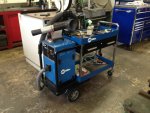welding seabee
Well-known member
- Messages
- 63
- Good Post Points
- 62
"D", as others have said above, AMPS is your problem. Those little 120V input units are designed for casual use on light weight material such as sheet metal. Trying to weld 1/4" material would require almost full depth beveling and several layers of weld material. I have a old MW AC/DC machine that does up to 230A on AC. It comes with a 30A 220V cord that is actually too light as at full amperage output it will pop a 30A breaker. Max primary amps on label is 47A. I changed the cord to a range cord and a 50 A breaker. Welding 1/4" plate like you have I still would bevel, gap thickness of the rod, and take two passes with 1/8" rod running as hot as I can control the puddle, maybe around 125A. I don't look at the numbers on the dial as much as the puddle to set amperage. That is feel for the puddle that practice develops. The puddle of molten base and rod material is either you friend or your enemy depending on you. That technique is best initially developed with a stick (SMAW) machine. Lastly, you cannot get a sound weld laying molten rod on top, it has to get down to the bottom of the joint and build out to the top. The size of the metal deposit on top of the base material has no bearing on strength of the joint. Talking butt welds here, lap joints need weld deposit both sides the height of the base material thickness and deep penetration (high amps). I have redone many welds on shop fabricated mass produced stuff done by MIG than I want to discuss, all just laid on top, no joint fusion at all.
LOL, Ron
LOL, Ron



